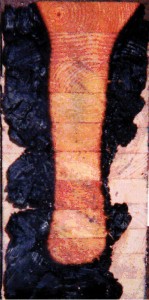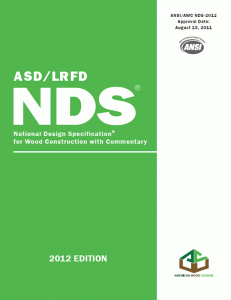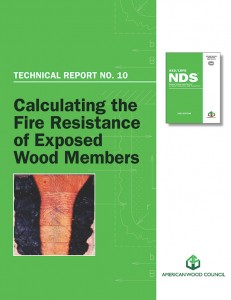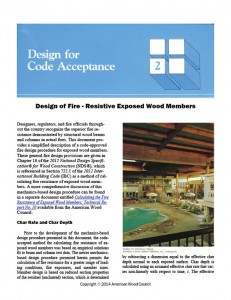The model building codes in the U.S. cover virtually every safety-related topic associated with construction of buildings. Fire-related issues comprise a surprisingly large portion of the model codes. Designing for fire safety is a complex and multifaceted issue. Discussion in this article is limited to design of exposed wood members. Additional information on building code requirements for wood can be found in the American Wood Council’s (AWC) Code Conforming Wood Design documents, available for free download.

The fire resistance of exposed wood members, including lumber, glued laminated timber, and structural composite lumber (SCL), may be calculated per IBC Section 722.1.
Fire Design of Exposed Wood Members
The fire resistance of exposed wood members, including lumber, glued laminated timber, and structural composite lumber (SCL), may be calculated using provisions of Chapter 16 of AWC’s National Design Specification® (NDS®) for Wood Construction. This allowable stress design approach is referenced in 2012 International Building Code (IBC) Section 722.1. The design procedure allows calculation of the capacity of exposed wood members using basic wood engineering mechanics. Actual mechanical and physical properties of the wood are used, and member capacity is directly calculated for a given period of time – up to 2 hours. Section properties are computed assuming an effective char rate, βeff, at a given time, t. Reductions of strength and stiffness of wood directly adjacent to the char layer are addressed by accelerating the char rate by 20 percent. Average member strength properties are approximated from existing accepted procedures used to calculate design properties. Finally, wood members are designed using accepted engineering procedures found in NDS for allowable stress design. Note, the design procedures presented in NDS Chapter 16 are not intended to be used for design and retrofit of a structure after a fire event.
The 2012 and earlier versions of the International Building Code (2012 IBC 722.6.3) have also contained an empirical calculation method for estimating the structural fire resistance of wood beams and columns exposed to a standard fire exposure for up to 1 hour. However, this empirical method has been deleted in the 2015 IBC in favor of the provisions contained within NDS Chapter 16, which are much broader in application and leave less room for design error.

The calculation procedure for fire-resistance of exposed wood members is found in Chapter 16 of AWC’s National Design Specification (NDS) for Wood Construction.
Basis for NDS Chapter 16 Approach
AWC’s Technical Report No. 10 (TR 10), Calculating the Fire Resistance of Exposed Wood Members, contains full details of the NDS method as well as design examples, and is available for free download. TR 10 was recently revised to incorporate the following:
- A new section that supports the use of the design method with smaller dimension sizes associated with lumber joist floor assemblies;
- Revised design examples to match the 2012 NDS;
- Revised design tables in Appendix A, which allows more accurate calculation of fire resistance of columns with any slenderness ratio, eliminates tabulation of very special cases that can be misapplied (i.e., deleted beams that are exposed on 4-sides that are assumed to be fully-braced throughout the fire rating, columns that are only exposed on 3-sides but are assumed to be unbraced, and tension members that do not resist flexure due to member dead load), and more in-depth discussion of how the tables were developed; and
- A new Appendix B that calculates the fire resistance of single-span lumber joists for any design stress ratio when joists are exposed on 3-sides and braced on the top edge.

AWC’s Technical Report No. 10 (TR 10): Calculating the Fire Resistance of Exposed Wood Members, contains full details of the NDS method as well as design examples, and is available for free download at www.awc.org.
Simplified Approach
AWC’s Design for Code Acceptance 2 (DCA 2): Design of Fire-Resistive Exposed Wood Members has been revised to replace the empirical design equations currently in the 2012 IBC with simplified design information developed in accordance with the code-approved NDS fire design procedure for exposed wood members. The tables and examples have been rewritten for consistency with the approach outlined in the 2012 NDS and TR 10.
For beams and columns stressed in one principal direction, simplifications can be made which allow the creation of load ratio tables. These load ratio tables can be used to determine the structural design load ratio at which the member has sufficient capacity for a given fire resistance time. Tables in DCA 2 give load ratios corresponding to 1-hour, 1½-hour and 2-hour fire resistance ratings for specified member dimensions. All tabulated load ratios apply to standard reference conditions where the load duration factor, wet service factor, and temperature factor equal 1.0 (CD=1.0; CM=1.0; Ct=1.0). For more complex calculations where stress interactions must be considered, or where standard reference conditions do not apply, designers should use the provisions outlined in TR 10, along with the appropriate NDS provisions.

Design of Fire-Resistive Exposed Wood Members (DCA2) replaces the empirical design equations in the 2012 IBC with simplified design information developed in accordance with the NDS for exposed wood members, and is available for free download at www.awc.org.
Conclusion
Designers, regulators, and fire officials throughout the country recognize the superior fire resistance demonstrated by structural wood beams and columns in actual fires. Structural fire design provisions have been incorporated in Chapter 16 of the NDS, which is referenced in Section 722.1 of the 2012 IBC as a method of calculating fire resistance of exposed wood members. A comprehensive discussion of this mechanics-based design procedure can be found in Technical Report No. 10, while DCA 2 provides a simplified description of this code-approved fire design procedure for exposed wood members. Both documents, available for free download, provide simple design tables, connection details, and other design information to facilitate fire design of exposed wood members.▪
